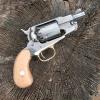Sign in to follow this
Followers
0

New To Leather, Holster Question
By
Dieselman, in Gun Holsters, Rifle Slings and Knife Sheathes

By
Dieselman, in Gun Holsters, Rifle Slings and Knife Sheathes